Jiyeh (Lebanon)
Jiyeh (Porphyreon) and Chhîm Archaeological Projects
Dates: 27 June — 8 August 2009
Team:
Director: Dr. Tomasz Waliszewski, archaeologist (IAUW)
Miron Bogacki, photographer (IAUW)
Karol Czajkowski, photogrammetrist
Angelika Dłuska, documentalist
Dr. Krzysztof Domżalski, archaeologist/ceramologist (IAE PAN)
Karol Juchniewicz, archaeologist (IAUW)
Jolanta Juchniewicz, architect (Warsaw University of Technology)
Zofia Kowarska, archaeologist (IAUW)
Szymon Lenarczyk, archaeologist (IAUW)
Magdalena Makowska, documentalist
Agnieszka Szulc, archaeologist
Dr. Mahmud El-Tayeb, archaeologist (IAUW)
Urszula Wicenciak, archaeologist/ceramologist (UKSW)
Archaeology student-trainees (IAUW): Iwona Brodzka, Mariusz Gwiazda, Iwona Janeczko, Karol Ochnio, Jarosław Paszkiewicz, Karolina Pawlik, Joanna Pazio, Bartosz Wójcik, Anna Zawadzińska
Continued explorations of the Roman and Byzantine settlement of Jiyeh, the ancient Porphyreon, went into the second season of a three-year project focused on the investigation of a Roman-age habitation district in this seashore town (see the internet PCMA Newsletter for 2008). The site (modern Jiyeh—Nabi Younis) lies 25 km south of Beirut and has been investigated by a Polish expedition since 2003 (for reports, see the annual Polish Archaeology in the Mediterranean). The work has been of an emergency nature for most of the time, battling the threat of encroaching modern architecture. Military action in 2006 interrupted the project completely and resulted in only a study season being carried out in 2007. In 2008, it was possible to return to the site with a full-scale campaign of fieldwork.
One of the major discoveries in past seasons was the identification of a major pottery production center from the Late Hellenistic and Early Roman period. The material is being studied by Urszula Wicenciak for her PhD thesis. The team has also explored and protected vestiges of a Byzantine-period basilica (see PAM XV Reports 2005). The newest three-year project is designed to investigate settlement structure and chronology, contributing data for a full publication of the site.
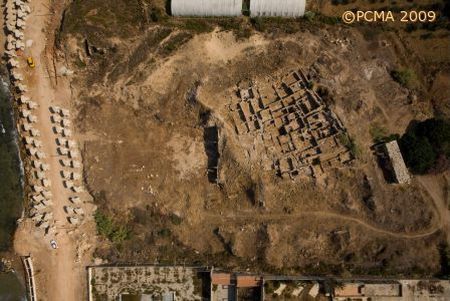
The present work, which follows up on last year’s clearing of more than 70 rooms (altogether 1500 sq. m), was not area extensive — only three new rooms were explored in the sector next to the eastern wall of the Byzantine basilica.
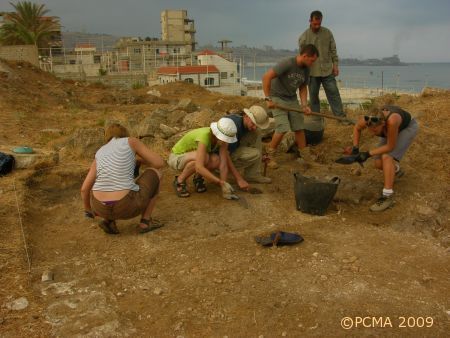
Instead, the team concentrated on the stratigraphic trenches exploring the layers under the habitation complex. Four such trenches were completed. The ones under rooms 4 and 72 revealed Hellenistic layers just under the Roman floors. The other two trenches (under rooms 4 and 20) reached deeper-lying strata, demonstrating that the origins of the site go back to the Late Bronze Age (13th-12th century BC) with another episode of settlement in the Iron Age (8th-7th century BC). Previous to this work, Jiyeh was considered to be no earlier than the Late Hellenistic—Early Roman period.
The team continued to document finds kept at the Museum-Palace of Beiteddine and the National Museum in Beirut, recorded as coming from the 1975 excavations of the site. This season the extensive collection of metal artifacts was documented and studied for the purposes of the future publication of the site.
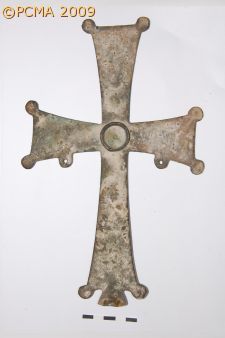
In addition to the main effort at Jiyeh, work was carried out at Chhîm, where explorations were completed of a cistern (C.VI) situated under the north wall of the 2nd century Roman temple. The assemblage recovered from the fill has proved to be exceptionally homogeneous. Apart from some 2nd-century rubbish found at the bottom of the feature, most of its almost 7-m depth was filled with archaeological material than can be placed securely within about thirty years right after the middle of the 6th century AD.
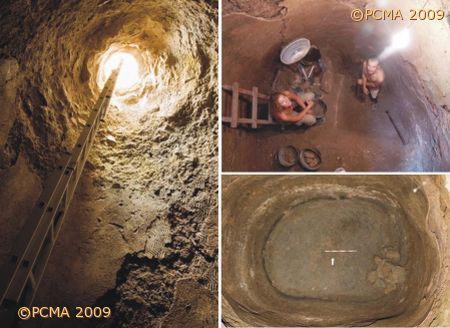
The assemblage is exceptionally uniform in character, comprising a limited repertoire of imported fine wares (LRW and Phocaean Red Slip), local ceramics, glass lamp fragments, and terracotta oil lamps. The latter are particularly interesting, considering that 197 fragments represent a single type of lamp (illustrated here) which is extremely characteristic of the southern Levantine coast between Beirut and Caesarea Maritima. Laboratory studies of the lamps recovered from the cistern should providing interesting data on clay sources, potentially leading to a discerning of groups or, better still, workshops producing this extremely popular form of lamp. Comparisons with the coarse ware characteristic of the region should demonstrate how local indeed was this type.
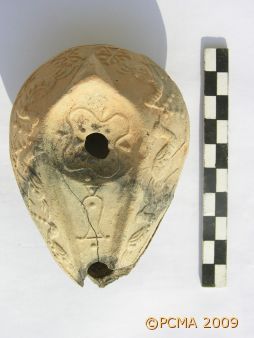
Apart from this set, the cistern also yielded five fragments of North African lamps and three fragments of the so-called candlestick lamps that were produced from the mid 6th until the end of the 7th century in the neighborhood of Jerusalem. These lamps were typical pilgrim souvenirs and their presence in the assemblage may be evidence for the villagers going on pilgrimages to the holy places. There is every reason to think that the cistern was filled over a fairly short period with discarded objects from a church establishment. Studies of the material, which are underway, will help to fine-hone the chronology of particular find categories.
[Text based on information from T. Waliszewski]
Local amphora production at Jiyeh
Testing and salvage work at Jiyeh in past seasons (tests B1-B3, well B4 and long section C between the basilica and necropolis) revealed large concentrations of fairly standard pottery of the so-called brittle-ware type and other coarse-ware. Some misfired fragments and other wasters testified to the presence of a pottery production centre on the site. Four different variants of one type of amphora were recognized in the first test pits (Fig. 1: Type 1). The well yielded an assemblage of pottery sherds consisting largely of a single amphora type (Fig. 1: Type 2 = Beirut type 2, according to P. Reynolds [2003]). Finally, the finds from the section were dominated by sherds belonging to one of two types (Fig. 1: Types 3, 4). Wasters of one of these types (Type 4) were also among the finds, a fact which confirms a local production of this form. Further work on the site has brought consistently extensive assemblages of locally produced amphorae along with abundant wasters representing three of the types illustrated below. This production can be dated to the 2nd century BC through the 3rd/4th century AD. Determining the chemical composition of the amphorae and wasters will confirm their origin. A study of this production center is the subject of a PhD thesis prepared by Urszula Wicenciak (Pottery production in late Hellenistic and early Roman Phoenicia: the ceramic production site at Jiyeh-Porphyreon (Lebanon), a case study and interpretation).
For more information, see relevant sub-chapters by U. Wicenciak in T. Waliszewski et alii, Jiyeh (Porphyreon). Hellenistic, Roman and Byzantine settlement on the south coast of Lebanon. Preliminary report on 1997 and 2003-2005 seasons, Bulletin d’Archeologie et d’Architecture Libanaises (BAAL) 10, 2006, 5-85.
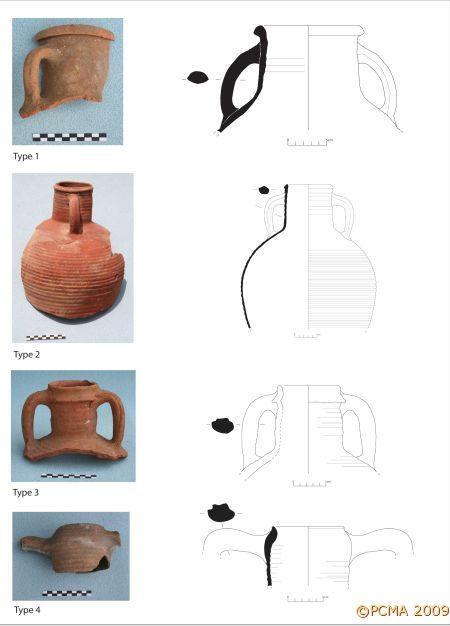
Workshop
Deutsches Archäologisches Institut, Orientabteilung
Berlin, December 4-5, 2009
Friday, December 4
09.30-10.00 Opening (M. van Ess – T. Waliszewski)
10.00-10.20 Margarete van Ess (Berlin) – Klaus Rheidt (Cottbus)
Baalbek 2001-2009. Introduction to the project.
10.20-10.40 Tomasz Waliszewski (Warsaw) – Karol Juchniewicz (Warsaw)
Chhîm 1996-2009. Introduction to the project.
Jiyeh-Porphyreon 2004-2009. Introduction to the project
10.40-11.10 coffee break
11.10-11.30 Mahmud el Tayeb (Warsaw)
Iqlîm el Kharrub Survey 2000-2009. Introduction to the project
11.30-11.50 Krzysztof Jakubiak (Warsaw)
Eshmun Valley Survey 2005-2009. Introduction to the project
11.50-12.10 Bettina Genz (Berlin) – Holger Ehrig (Berlin)
Survey of rural settlements around Baalbek. Introduction to the project
12.10-13.30 lunch break
13.30-13.50 Ingrid Périssé (Lyon)
The evolution of the sanctuary at Chhîm
13.50-14.10 Daniel Lohmann (Aachen)
The evolution of the Jupiter sanctuary in Baalbek
14.10-14.30 Friederike Hoebel (Cottbus/Freiburg)
The evolution of the Venus sanctuary in Baalbek
14.30-14.50 Marzena Łuszczewska (Warsaw)
Roman period architectural decoration elements from Chhîm
14.50-15.10 Holger Wienholz (Berlin)
Roman period architectural decoration from Baalbek
15.10-15.40 coffee break
15.40-16.00 Mariusz Gwiazda (Warsaw)
Preliminary remarks on doors, windows and communication in Chhîm and Jiyeh
16.00-16.20 Clemens Brünenberg (Berlin)
Remarks on the architectural features of Roman public buildings in Baalbek
16.20-16.40 Heike Lehmann (Cottbus)
The rural dwelling of the Beqaa in urban context. The “Ḥay aṣ-Ṣolḥ“ – a traditional living quarter in Baalbek
16.40-17.00 coffee break
17.00-18.00 discussion
Saturday, December 5
09.30-09.50 Krzysztof Domżalski (Warsaw)
Hellenistic and Roman fine ware pottery from Chhîm and Jiyeh
09.50-10.10 Olga Wasilewska (Warsaw)
Roman Lamps from Chhîm and Jiyeh
10.10-10.30 Bettina Genz (Berlin)
Hellenistic and Roman Lamps from Baalbek
10.30-10.50 Tomasz Waliszewski (Warsaw)
Late antique lamps from Chhîm and Jiyeh
10.50-11.20 coffee break
11.20-11.40 Marcin Wagner (Warsaw)
Hellenistic, Roman and Byzantine glass vessels from Chhîm and Jiyeh
11.40-12.00 Hanna Hamel (Berlin) – Franziska Jahnke (Berlin)
Roman Glass from Baallbek.
12.00-12.20 Agnieszka Szulc-Kajak (Warsaw)
Metal objects from Jiyeh.
12.20-14.00 lunch break
14.00-14.20 Monika Karnowska (Warsaw)
Preliminary remarks on the archaeozoological remains from Chhîm and Jiyeh
14.20-14.40 Olga Wasilewska (Warsaw)
Roman necropolis in Jiyeh. Burials and funerary customs
14.40-15.00 Lars Petersen (Bochum)
Roman sarcophagi from Baalbek
15.00-15.20 Karol Juchniewicz (Warsaw)
Roman and Byzantine period water management system in Chhîm and Jiyeh
15.20-15.40 Juliane Schmidt (Cottbus)
Water distribution and management in Baalbek
15.40-16.00 coffee break
16.00-17.00 future planning
17.00-18.00 discussion (work groups)
